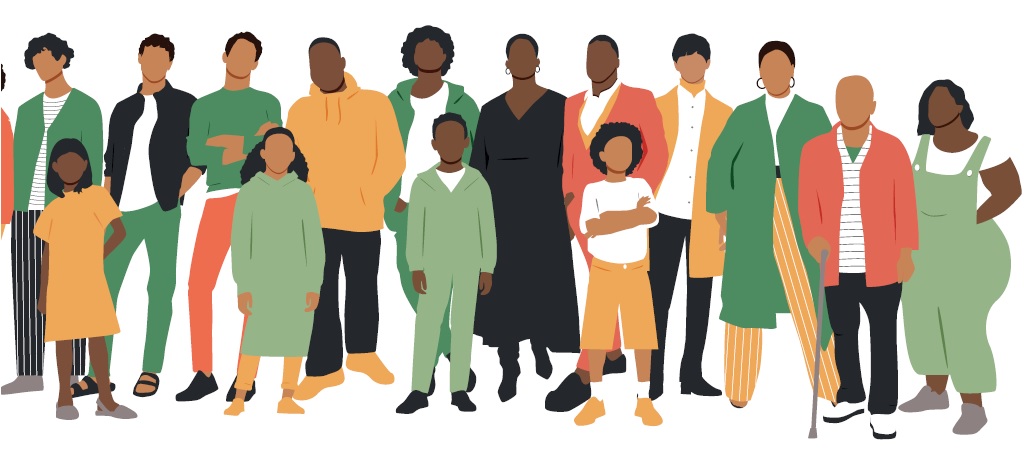Written by Steven Hubbard, Senior Data Scientist
Black immigrants make up a vital part of America’s rich cultural life. Think of authors Chinua Achebe and Chimamanda Ngozi Adichie; musicians Miriam Makeba and Wyclef Jean; comedian Trevor Noah; activist Marcus Garvey; NBA hall of famer and philanthropist Dikembe Mutombo—to name but a very few. For generations across the United States, Black immigrants have enriched our academics, music, cuisine, fashion, dance, and more.
Overall Population of Black Immigrants
But Black immigrants also play an increasingly important role in our economy and political landscape. The United States is currently home to more than 4 million Black immigrants. In the last decade, the population of Black immigrants grew 19.4%, from 3.4 million in 2011 to 4.1 million in 2021. While nationally Black immigrants comprise 1.2% of the population, their concentrations are triple that in some states, such as Maryland, New York, and Florida. Black immigrants are defined as any person who was born outside the United States to non-U.S. citizen parents and who identifies as Black or African American in the American Community Survey.
The five states with the highest population of Black immigrants are New York, Florida, Texas, Maryland, and New Jersey. Nationally, the two largest regions of birth for Black immigrants are Sub-Saharan Africa (47.4%) and the Caribbean (46.4%). However, significant numbers of Black immigrants also come from Central and South America, as well as Canada, Germany, and other countries.
Five States with Highest Numbers of Black Immigrants
| State | Black Immigrants | Total Population | Share of State Population |
| New York | 737,458 | 19,835,912 | 3.7% |
| Florida | 676,580 | 21,781,128 | 3.1% |
| Texas | 319,911 | 29,527,940 | 1.1% |
| Maryland | 239,158 | 6,165,129 | 3.9% |
| New Jersey | 225,205 | 9,267,130 | 2.4% |
The Black immigrant community is expanding at a fast pace in certain states. For example, in about the last decade the Black immigrant population of Texas nearly doubled, rising from 161,506 in 2010 to 319,911 in 2021.
Maryland had the highest share of Black immigrants in the United States, at 3.9%, and New York had the second highest share, at 3.7% of the state population. Recent findings from Pew Research Center reveal that Black immigrants will contribute to around one-third of the growth of the Black population from now to 2060.
Black Immigrants’ Spending and Political Power
Black immigrants make significant contributions to the U.S. economy. In 2021, Black immigrant households generated a total income of $153 billion. They paid $39 billion in taxes: $24 billion in federal income taxes and $15 billion in state and local taxes. This left Black immigrant households with $114 billion in spending power—money households used to support American businesses, invest in housing, and more. As the Black immigrant population grows, so does their spending power—it increased by 7.1% from 2018 to 2021.
While Black immigrants make up a small percentage of the overall U.S. population, they are obviously more highly concentrated in some cities and states. In these areas, the concentration of Black immigrants means that they may be able to exert more considerable electoral pressure in state or local elections. For example, while there were 2.4 million eligible Black immigrant voters in the United States in 2021, a full 38.7% of those voters lived in either New York state or Florida.
Contributions to the U.S. Workforce
Black immigrants also make vital contributions to the workforce, particularly in industries facing ongoing labor shortages, such as healthcare and transportation. For example, Black immigrants are more likely to work in healthcare than are other immigrant groups. In 2021, a total of 719,000 Black immigrants worked in the healthcare and social assistance industry, representing 3.3% of the industry’s total workforce. Within healthcare occupations, 152,000 Black immigrants worked as home health and personal care aides, 130,000 as registered nurses, and 16,000 as physicians.
The industry with the second highest percentage of Black immigrant workers was transportation and warehousing. In 2021, 254,000 Black immigrants worked in transportation and warehousing, comprising 3.2% of the workforce. Of those, more than 80,000 were employed as truck drivers, an occupation that, along with many jobs in healthcare, is experiencing a significant demand for workers.
Black immigrants have made significant contributions to American culture, as well as to the U.S. economy. Their population is growing rapidly, along with their spending power and tax contributions. They also provide essential labor in fields experiencing a critical shortage of workers, such as healthcare and transportation. And, as the population of Black immigrants continues to increase and become more politically engaged, its influence in the United States will only grow.
FILED UNDER: american community survey


